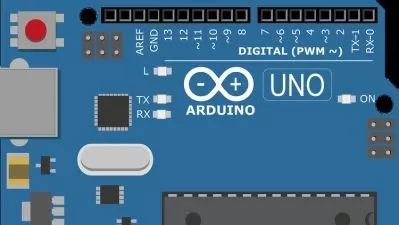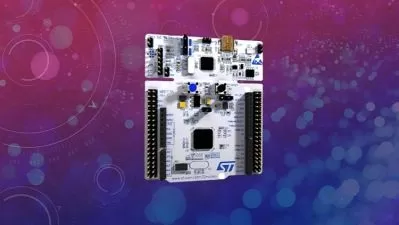STM32 bare metal guide for future embedded projects (part 1)
Boyan Lazic
4:21:25
Description
Learn programming of embedded devices using STM32F407VG in Embedded C without libraries only registers
What You'll Learn?
- Memory map and what are the parts of memory
- Use pointers to edit data in memory
- Different ways to access and edit data in memory
- Bitwise operations on data
- Endianness of a device
- Understanding GPIO and going through output and input
- Understanding NVIC and triggering interrupts
- Understanding the SYSCLK and going through its configuration
- Understanding the TIMER and going through its various functionalities
- Understanding DMA and going through its functionality
Who is this for?
More details
DescriptionThis course was created mostly for students, but also for people wishing to start their career on this path to gain general knowledge of embedded systems.
When starting with embedded systems, from my experience and the experience of others, the problem is that there are many unclarities when it comes to reading the documentation and schematics, and later on combining it with programming at the beginning of their studies or research.
This course was made exactly to bridge those gaps and give them insight how simple it is to achieve many functionalities, all by going step-by-step through the reference manual, schematics and programming the device. During the course, all the concepts will be graphically explained. I think that visual learning is the best way of learning.
Because this field is such that just by talking you can't reach lot, so you must show some results, at the end of every important step, an experiment will be conducted to show the proof. This can also help students or employee beginners with their projects. The device that was used in this course is the STM32F407VG discovery board.
The only libraries and instructions that are used in this course, are the ones that can be used on any other C compiler. Everything else is self-made. The course content is kept minimalistic.
During the course you'll learn about:
- Memory access and editing
- General Purpose Input Output (GPIO)
- Interrupts
- Nested Vector Interrupt Controlelr (NVIC)
- Clocks (HSI, HSE, PLL)
- Timers (and functionalities)
- Direct Memory Access (DMA)
I'm open to feedback on:
- what was explained well?
- what wasn't?
- where to put more emphasis on?
- is something missing?
- what would you like to see but was not covered? (it can also be something unrelated to the given topics)
The feedback is optional, it's supposed to be less about me, but more about others.
Those who decide to share their opinion, I would ask for constructive feedback, because that way I can consider it and make new courses better and more understandable for future viewers.
For the first 30-days I'm open to answering all questions regarding the course
Who this course is for:
- Students and beginners to embedded systems
This course was created mostly for students, but also for people wishing to start their career on this path to gain general knowledge of embedded systems.
When starting with embedded systems, from my experience and the experience of others, the problem is that there are many unclarities when it comes to reading the documentation and schematics, and later on combining it with programming at the beginning of their studies or research.
This course was made exactly to bridge those gaps and give them insight how simple it is to achieve many functionalities, all by going step-by-step through the reference manual, schematics and programming the device. During the course, all the concepts will be graphically explained. I think that visual learning is the best way of learning.
Because this field is such that just by talking you can't reach lot, so you must show some results, at the end of every important step, an experiment will be conducted to show the proof. This can also help students or employee beginners with their projects. The device that was used in this course is the STM32F407VG discovery board.
The only libraries and instructions that are used in this course, are the ones that can be used on any other C compiler. Everything else is self-made. The course content is kept minimalistic.
During the course you'll learn about:
- Memory access and editing
- General Purpose Input Output (GPIO)
- Interrupts
- Nested Vector Interrupt Controlelr (NVIC)
- Clocks (HSI, HSE, PLL)
- Timers (and functionalities)
- Direct Memory Access (DMA)
I'm open to feedback on:
- what was explained well?
- what wasn't?
- where to put more emphasis on?
- is something missing?
- what would you like to see but was not covered? (it can also be something unrelated to the given topics)
The feedback is optional, it's supposed to be less about me, but more about others.
Those who decide to share their opinion, I would ask for constructive feedback, because that way I can consider it and make new courses better and more understandable for future viewers.
For the first 30-days I'm open to answering all questions regarding the course
Who this course is for:
- Students and beginners to embedded systems
User Reviews
Rating
Boyan Lazic
Instructor's Courses
Udemy
View courses Udemy- language english
- Training sessions 34
- duration 4:21:25
- Release Date 2023/05/18
















